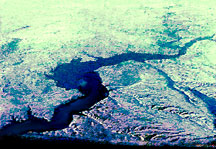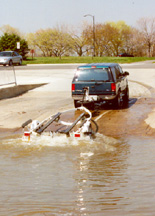
|
 Back to The Water Back to The Water
Our Bay Makes Us Rich — In More Ways Than One
by Sandra Martin
Chesapeake Bay reaches out to the land the way a hand reaches into a glove. It’s the watery yin to Chesapeake Country’s yang. It’s the rejuvenation of our winter-worn selves.
Most years, a Bay-lover can be out on the water every month of the year. I’ve boat picnicked in November and December, kayaked in January, February and March and fished in April. And that’s just one person’s take on off-season pleasures. The Frostbite League sails from November into March. Fishermen claim rockfishing is at its best in November and December, and they’re out again in ruthless April and fickle May. The big blows of fall and spring make windsurfers happy as clams.
This year, you’ve had to be hardy indeed to dare the Bay — unless you’ve been set to seize one of the rare, sunny days.
But Memorial Day is supposed to change all that. On this weekend, Mother Nature should say Open, Sesame!, and our water-going selves will pop out of dry-dock.
Heeding the call of the Bay brings tens of thousands of pleasures to Chesapeake citizens. That’s pleasure enough to float many a boat, for just as Chesapeake Country is a diverse nation, there are many, many ways of getting out on our Bay.
$1.6 Billion Boat Dollars
To our economy, all those pleasures add hundreds of millions of dollars.
“Marine trades are a billion-dollar industry, right up there with horses and government,” says Mick Blackistone, founding director of the Anne Arundel and Maryland Marine Trades Association and for many years a lobbyist for the national industry in Washington. “The three intermingle with one or the other for the top spot, depending on the year.”
Environmental advocates who point to the Chesapeake economy as a key reason to protect the Bay aren’t kidding: Boaters spent some $1.6 billion in Maryland in 2000. To be that specific, University of Maryland’s Sea Grant College does an annual survey, the “Economic Impact of Maryland Boating.” (2000 figures are the most recent for comparable state and county breakdowns.)
Translating dollars to jobs, recreational boating creates 19,990 full-time equivalent jobs for the state. “Look at indirect and induced effects,” survey analyst Douglas Lipton says, and the impact rises to 28,200 jobs.
Where does all that money come from?

From the 200,000-plus sail and power boats licensed by the Maryland Department of Natural Resources. (2000’s 220,828 licensed boats decreased to 209,223 in 2001.)
Those boats range from the bathtub-sized Opti’s of West River Sailing Club and 16-foot Carolina skiffs at Bunky’s Charterboats in Solomons to the 65-foot, 100-passenger fishing boats Tom Hooker and Lady Hooker at Rod ’n’ Reel in Chesapeake Beach.
In the mid-range of such boats for hire are 36- to 55-foot charter fishing boats, many of them Bay-builts still made in the shops of local boatwrights. Calvert County is port for more charter boats than any other county in the state. Close to 100 appear on the county’s website, www.co.cal.md.us/cced/guide/charterboat.htm. The closest fishing fleet to Washington, D.C., is situated over the Anne Arundel County line in Deale.
Ninety percent of boats licensed in Maryland are powerboats, with the vast majority of those — consistently 160,000 or more in the 21st century — small trailerable boats from johnboats to Zodiacs to jetskis. Each one of those trailerable boats costs its owner an average $1,614 a year — not counting a single day on the Bay. Each excursion, according to the Economic Impact survey, costs another $190.
Walk or cruise the docks of the more than 630 in Anne Arundel and Calvert counties, and you’ll see even more ways to enjoy the Bay. The power boats among those 220,000 range from runabouts to cigarette boats to houseboats to trawlers to fishing boats to cabin cruisers that themselves range from bungalows to the poorer relations of Queen Elizabeth. Reduced to averages, each of those bigger, slipped power boats costs its owner $4,013 each year — plus $227 per excursion.
Sailors’ pleasures are just as diverse. One sailor’s pride and joy is a modernistic catamaran, while another delights in the wood craftsmanship of a Cheoy Lee. This one races a sleek, stripped down J-Boat, and that one a Beneteau, fitted with every comfort — close to the top is the 72-foot custom-built Santa Cruz yacht Donnybrook. By the dollar, each sailboat costs an average of $5,538 to stay in its slip. Take it out on the Bay and add $166 per excursion.
Now that you know what your pleasures cost, you’ll be glad to know that the ripple effect of those dollars adds up so that “each boat contributes over $66,000 a year in economic activity,” according to Lipton.
So you know why Mike and Robin Kelly (whose story follows) have resisted the urge to buy themselves a boat.
Not that the Kellys — and all the other thousands who rent their Bay pleasures by the day — are shirking their duties to the economy.
 In Calvert and any other shore-side county, thousands of fishermen a season share a ‘six-pack’ charter fee of about $550 plus tips for the mate for a day of fishing, usually featuring trolling or chumming for rockfish, on the Bay. For a cheaper day on the Bay, bottom-fishing for the likes of croaker and spot on a “headboat” like Tom Hooker costs $37 plus $5 to rent the rod — with a dozen bloodworms thrown in. In Calvert and any other shore-side county, thousands of fishermen a season share a ‘six-pack’ charter fee of about $550 plus tips for the mate for a day of fishing, usually featuring trolling or chumming for rockfish, on the Bay. For a cheaper day on the Bay, bottom-fishing for the likes of croaker and spot on a “headboat” like Tom Hooker costs $37 plus $5 to rent the rod — with a dozen bloodworms thrown in.
By-the-day sailors contribute their share, too. You can charter a sailboat, with captain or without, in a range of prices from high to higher. And you can learn to sail at close to a dozen sailing schools in Chesapeake Country.
The Kellys’ Baltimore excursion on the Annapolitan II costs $56. You can ride the Annapolis watertaxi for as little as $2. The Deale watertaxi is even cheaper: free, though you’re supposed to tip.
Ripple Effect
Big or little, your dollars are reinvested in the $1.6-billion Chesapeake Bay marine economy in boat, slip, fuel, bait, fishing tackle, labor and an array of invisible goods and services picked up by the University of Maryland Survey.
At the county level, you can see just how big those ripples are. In 2000, Calvert County grew $39,777,876 richer from its marine economy. Anne Arundel, at four and a half times larger, profited $400,162,291 from marine trades.
Translating dollars to jobs, Lipton says “Every eight to nine boats leads to a full-time job somewhere in the state’s economy.”
 Somewhere is big territory. One way of mapping it is the membership of the Maryland Marine Trades Association. Their members, according to director Susan Zeller, include “everything from marine accountants, bankers and insurance reps to carpenters and riggers to canvas or sail lofts; from mechanics to professional service consultants; from sales reps to surveyors, brokers and captains. There are even painters and photographers who specialize in boats.” Somewhere is big territory. One way of mapping it is the membership of the Maryland Marine Trades Association. Their members, according to director Susan Zeller, include “everything from marine accountants, bankers and insurance reps to carpenters and riggers to canvas or sail lofts; from mechanics to professional service consultants; from sales reps to surveyors, brokers and captains. There are even painters and photographers who specialize in boats.”
Even Bay Weekly’s boat rises with Chesapeake Country’s water economy.
Good as getting back to the water is for business, it’s better for souls. Time spent on the Bay and its tributaries buys you slow hours of elemental pleasures: the roll of the water, the rush of the wind, the colors on sunset in sky and water, the tug — and taste — of a fish. If you’ve done it, we don’t have to tell you. If you haven’t, summer 2003 is time you find out for yourself.
The cost of getting back to the water doesn’t have to make you seasick. From beachcombing to swimming to lounging in your inflatable rubber ducky to canoeing and kayaking, there are cheaper ways to get wet in our beautiful Bay. To find out all about them, you’ll have to wait until June 19, when we publish the 2003 edition of 101 Ways to Have Fun, Bay Weekly’s Indispensable Guide to Summer on the Bay.
to the top
|
|


 Back to The Water
Back to The Water
 In Calvert and any other shore-side county, thousands of fishermen a season share a ‘six-pack’ charter fee of about $550 plus tips for the mate for a day of fishing, usually featuring trolling or chumming for rockfish, on the Bay. For a cheaper day on the Bay, bottom-fishing for the likes of croaker and spot on a “headboat” like Tom Hooker costs $37 plus $5 to rent the rod — with a dozen bloodworms thrown in.
In Calvert and any other shore-side county, thousands of fishermen a season share a ‘six-pack’ charter fee of about $550 plus tips for the mate for a day of fishing, usually featuring trolling or chumming for rockfish, on the Bay. For a cheaper day on the Bay, bottom-fishing for the likes of croaker and spot on a “headboat” like Tom Hooker costs $37 plus $5 to rent the rod — with a dozen bloodworms thrown in. Somewhere is big territory. One way of mapping it is the membership of the Maryland Marine Trades Association. Their members, according to director Susan Zeller, include “everything from marine accountants, bankers and insurance reps to carpenters and riggers to canvas or sail lofts; from mechanics to professional service consultants; from sales reps to surveyors, brokers and captains. There are even painters and photographers who specialize in boats.”
Somewhere is big territory. One way of mapping it is the membership of the Maryland Marine Trades Association. Their members, according to director Susan Zeller, include “everything from marine accountants, bankers and insurance reps to carpenters and riggers to canvas or sail lofts; from mechanics to professional service consultants; from sales reps to surveyors, brokers and captains. There are even painters and photographers who specialize in boats.”